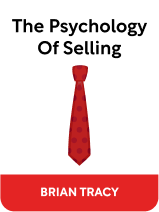

This article is an excerpt from the Shortform book guide to "The Psychology Of Selling" by Brian Tracy. Shortform has the world's best summaries and analyses of books you should be reading.
Like this article? Sign up for a free trial here .
What is Brian Tracy’s The Psychology of Selling about? What do successful salespeople do differently?
In The Psychology of Selling, bestselling author and management consultant Brian Tracy explains how you can become a top salesperson by understanding how your customers think. He walks you through basic and advanced selling techniques, demonstrating how you can dramatically increase your sales success by improving your skills just a little bit on a consistent basis.
Below is a brief overview of the key points from The Psychology of Selling by Brian Tracy.
The Psychology of Selling: Increase Your Sales Faster and Easier Than You Ever Thought Possible
People who succeed in sales have high incomes and job security. However, while many people enter the profession, only a few succeed. In fact, of every 100 salespeople, just four of them will earn as much as all the rest combined. The Psychology of Selling by Brian Tracy explains how you can become successful at sales by understanding the psychology behind top salespeople.
The Psychology Behind Successful Salespeople
There’s a wide discrepancy between the success of top salespeople and that of mediocre ones. In fact, the top 20 percent of salespeople make 80 percent of the money being earned in the profession as a whole—we call this the 80/20 rule. Further, the top 20 percent of that top 20 percent (equaling 4 percent of the total) makes 80 percent of those earnings. In other words, out of every 100 salespeople, there are four people who are earning as much as all the rest combined.
So how do you get into that top 20 percent of 20 percent? The answer begins with understanding the psychology of success.
Success Comes From a Winning Edge
To find success in sales, you need to develop a winning edge. A winning edge is a small advantage in capability or skill that adds up to a significant difference in results—like when a horse wins a race by just a nose but takes home 10 times the prize money as the horse in second place. The important thing to note here is that you only need an edge: a few things that you consistently do better than anyone else.
Success Comes From a Positive Attitude
Developing a winning edge starts by developing a positive self-concept—how you think about yourself, your skills, and other people. Your self-concept determines your attitude and how you approach the world in general and sales in particular.
Having a positive self-concept and a positive attitude will lead you to sales success in three ways:
- A positive attitude makes people feel positively about you and makes them more receptive to your sales pitch.
- A positive attitude inclines you to like your job, and you tend to spend more time doing things you enjoy. When you devote more time to something, you inevitably get better at it. Thus, if you enjoy doing the things that lead to sales (for example, prospecting or engaging with customers), you’ll do them more readily and consequently become better at them.
- Your self-concept determines your earnings comfort zone, or the income level at which you’ll be satisfied. Researchers have found that a person generally earns within 10 percent of what she determines her worth to be. If you see yourself as a $50,000-a-year person, you’ll behave in ways that will earn you approximately $50,000 a year. If you see yourself as a $100,000-a-year person, you’ll act accordingly.
Success Comes From Setting Goals
The most successful salespeople are the ones who set goals for themselves. Specific goals are far more helpful than vague goals. To set your goals and the subgoals you’ll need to accomplish them:
- Decide your annual income goal.
- Figure out how much you’ll need to sell annually to meet this income goal.
- Calculate how much you’ll need to sell monthly, weekly, and daily to meet this goal.
- Determine what specific activities you must do to reach those daily goals. How many calls will you need to make? How many presentations? How many follow-ups?
- Plan a daily schedule that will allow you to do those activities. If you’ll need to make 10 calls a day, what time do you need to start in the morning? Set subgoals throughout the day: for example, that you’ll have made six calls by 10 a.m.
Failure Comes From Fear
In the same way that the qualities that drive success are mental, the fears that drive failure are also mental. The primary fear that holds a salesperson back from success is the fear of rejection. The fear of rejection is triggered by the possibility of disapproval, judgment, or rudeness from a customer.
There are three truths you can internalize to help you get over your fear of rejection:
- Rejection is not personal: Rejection is an expected and normal part of sales.
- Courage takes practice: Showing up in the face of possible rejection takes courage. Fortunately, courage is like a muscle—the more you practice it, the stronger it gets.
- Positive thinking conquers fear of rejection: Repeat positive mantras to yourself (“I’m doing great! I love my work!”) whenever you feel yourself shying away from a situation. You’ll pump yourself up with positive thoughts and have less trouble facing that possible rejection.
The Psychology Behind Customers
Now that we’ve discussed some of the basic psychology that drives a salesperson’s success or failure, let’s look at some of the basic psychology that drives a customer’s decision to buy. Understanding customers starts by understanding that all buying decisions are emotional, not rational. Customers are driven by emotions of desire and fear.
Some of the basic desires that drive people to make a purchase include:
- Money and security
- Personal growth
- Love and companionship
- Health
- Status and prestige
The two main fears that prevent a person from making a purchase are:
- Fear of losing money: People often fear spending too much on a poorly judged purchase.
- Fear of making a mistake: People also fear buying something they later won’t want, don’t need, or that won’t help them in the way they’re anticipating.
Before Your Sales Meeting: Prospecting Techniques
Now that we’ve looked at the psychology behind sales, let’s move on to the techniques of sales. The first step in the selling process is getting an appointment. To do so, you’ll usually have to cold call: call up strangers and get them to agree to meet with you so that you can show them your product or service. This can be the hardest part of sales. To make it easier:
- Make sure to get the right person on the phone. You can’t sell to someone who doesn’t have the authority to buy or who won’t benefit from your product. Ask whoever answers the phone for the correct contact. Then ask to be connected to that person.
- Immediately grab your prospect’s attention by emphasizing the benefits she can expect from your product. For example, “Would you be interested in a proven method of increasing your sales by 40 percent over the next year?”
- Assure your prospect you’ll only need 10 minutes of her time. This puts her at ease and lets her know what to expect.
Counter Objections
You can expect some common responses and objections when you call a prospect, including:
- “Not interested”: If a prospect says, “We’re not in the market for that,” offer them social proof: proof that others value your product. People respond to the opinions of their peers. You might say, for example, “Most people in your industry felt the same way when I first called them. Now they’ve become our best customers, and they recommend us to their colleagues.”
- “Sell me now”: Sometimes a prospect asks you to run through your presentation right then on the phone. Respond by saying, “I would love to, but I have some things I need to show you so you can see how this product can help you.”
- “Mail me something”: Sometimes prospects ask for more material in the mail so that they can make a decision at a later time. Instead, offer to drop off the materials when you’re in the area.
- “Call me back later”: Sometimes a prospect will tell you to call back at another time to set up an appointment. Instead, suggest a date to meet and assure her she can cancel later if she needs to.
At Your Meeting: Selling Techniques
Once you’ve gotten an appointment, the next step is the actual sales meeting. Below, we’ll discuss some techniques you can use in your meetings to make your presentation as effective as possible.
Know Your Buyer
To really nail a presentation, tailor it to each particular prospect you speak with. There are six common types of customers:
- The Reluctant Customer: These customers are cynical and chronically uninterested. Don’t spend much time with this type of customer—she’s unlikely to say yes.
- The Certain Customer: This buyer will know exactly what features and benefits she needs and what price she’s prepared to pay for them. Offer her exactly what she’s looking for and don’t try to oversell.
- The Analytical Customer: These buyers move slowly to be sure they make the right decision. Focus on details and answer questions thoroughly.
- The Relationship Customer: This type of buyer wants to build a relationship before committing to a purchase. Slow down, ask lots of questions, and tell her about other satisfied customers.
- The Directive Customer: This buyer is busy, businesslike, and practical. Focus on the bottom line: exactly how your product can help her. Get right to the point so she doesn’t feel you’re wasting her time.
- The Social Customer: This buyer is talkative and friendly. Be positive and open in return. If she agrees to a purchase, be sure to get it in writing immediately; this type of buyer is prone to forgetting commitments soon after she makes them.
Open Strongly
No matter which type of customer you’re dealing with, you need to have a strong opening to your presentation. With either of the following openings, you get your customer to agree to give you an answer at the end of the presentation. This prevents her from putting you off at the end of your presentation with a vague, “I’ll get back to you later.”
- The fair exchange opening: With this opening, you propose a fair exchange: “All I ask is that you take a look at what I’m going to show you, think it over with an open mind, and at the end of our conversation, let me know if you think it applies to your situation. Does that sound fair?”
- The qualifier opening: With this opening, you establish whether or not your customer is in fact in a position to buy at the end of the meeting, and if so, how much she could spend. For example, you might say, “If I show you the smartest investment on the market, are you able to invest $10,000?” This changes the focus from, “Let me show you something” to “Are you capable of reaping these benefits?”
Show, Tell, Ask
Another great technique to keep your prospect engaged is to use the show-tell-ask structure. This is a simple but effective format for a presentation. Essentially, you show the prospect a feature, tell her how she would benefit, and ask follow-up questions.
- Show: Introduce one feature at a time.
- Tell: Focus on how your product’s feature will benefit your customer: “Because of (feature)… You can (benefit)… Which means (relevance)…” For example, if you were selling a flat-screen television, you might say, “Because of the pixel technology (feature), you can view the screen from any angle (benefit), which means when you have a party, everyone can enjoy the game (relevance).
- Ask: Build your questions upon one another to lead your prospect to the logical conclusion that buying your product is the right choice. “Are your highest performing salespeople also your most motivated ones?” “With our training program, salespeople immediately perform better, making them more motivated to work harder. Does that make sense to you?”
Have a Conversation With Your Customer
To override your customer’s fears with desires that are strong enough to convince her to buy from you, engage in a conversation that allows her to open up and tell you what she’s looking for. To do so, you’ll need to:
- Position yourself as trustworthy: Focus on helping your customer rather than selling your product.
- Ask questions: More often than not, if you let a customer talk, she’ll reveal to you what would convince her to buy. Ask questions that start with words like “what,” “how,” and “when,” that encourage detailed answers rather than yes-or-no answers.
- Emphasize your product’s key benefits: When a customer buys a product or a service, she only cares about what benefit it will bring to her or her business. Focus on how your product will help her.
Close Effectively
By the time you arrive at the close of your presentation, you should have prepared your prospect to be receptive to your request for the sale by setting up her expectations with a strong opening and by increasing her desire with a focus on benefits. A few guidelines that can help you seal the deal are:
- Close with a hot-button issue: The hot-button issue is the key benefit that your customer cares about most. Once you know her hot-button issue, continue to press it, over and over. Make the entire decision revolve around that issue.
- Assume the sale: As soon as you’ve identified your prospect’s hot-button issue, assume she agrees to the sale and act accordingly; for example, start filling out an order form.
- Use a trial close: Check in with your prospect at several points in your presentation to make sure you are on the right track and to test for your prospect’s readiness to close. For example, you might ask, “This copy machine will make 140 copies a minute. Would this be important to you?” This closing method allows you to adjust your presentation if she’s not responding to a feature.
Appeal to Your Customer’s Subconscious
During your meeting, you can increase the likelihood of a sale if you appeal to your customer’s subconscious mind with cues that lead her to think you’re professional, in control, and an expert in your field. You can do this by harnessing the power of suggestion, which plants ideas and beliefs in a person’s subconscious mind with subtle social hints. Some techniques to do this are:
- Dress well: Most of a person’s reaction to another person is subconscious, and the way a person is dressed has an outsized effect on that subconscious impression. Wear professional clothing and a business-appropriate hairstyle.
- Be energetic: Have good posture, walk confidently, and greet your prospect with a firm handshake.
- Ask expert questions: Questions allow you to position yourself as a professional expert. Asking intelligent, pointed questions convinces your customer that you are there to help her and that you’re diagnosing her problem as a doctor might. This decreases her sales resistance and skepticism.
- Draw your prospect out: Sometimes your prospect’s body language can convey distrust or reluctance. Simply getting a person to change her posture can change her mood. For example, if her arms are crossed, hand her something to get her to uncross them.
- Stay in control of the conversation: By controlling the tone and the direction of your meeting, you’ll prevent her from getting distracted, suddenly tuning out, or focusing on the wrong aspects of your presentation. Meet in a quiet place to minimize interruptions. Avoid having a physical barrier between you, such as a desk or table. Don’t present standing up, as you’ll come across as weak and unimportant, like someone who’s not been invited to stay.
(Shortform note: To further explore ways you can stay in control of your meeting, read our summary of Pitch Anything.)
Creative Selling Techniques
Now that we’ve covered some of the basics of the psychology underpinning sales as well as some basic and advanced selling techniques, we’ll look at how you can increase your creativity when you approach sales, enabling you to find more customers and opportunities. When you increase your creativity, you can:
- Find more—and better—prospects
- Ask more probing questions of your customers
- Present your product’s solutions more innovatively
- Answer your customer’s objections better
- Close the sale more effectively
- Find innovative ways of getting referrals
Educate Yourself
Before you can tap into the full potential of your creativity, you need as much information as possible about your product, your market, and your competition. Get specific and do a full analysis:
- Study your product: What are the five to 10 best features of your product? Why does a customer buy your product?
- Study your customers: What qualities does your ideal customer have? What qualities do most of your existing customers have? What changes are happening in your field at the moment? What other customers might benefit from your products or services that you haven’t reached yet?
- Study your competitors: Who are your primary and secondary competitors? Why does a customer buy this product from your company rather than a competitor’s? How does your product outperform your competitor’s?
Strategic Selling
Improve your creativity by thinking strategically. There are four strategic selling techniques you can use to greatly improve your sales success. Use these techniques as a framework within which you can get creative:
- Specialization: When you specialize, you focus on servicing a narrow customer segment. Get creative: Is there an underserved market you can enter?
- Differentiation: When you differentiate, you define what makes your product or your company different from a competitor’s. Get creative: How might you position a benefit so that it makes your product more special than another?
- Segmentation: Once you’ve established your area of specialization and what differentiates you from your competition, examine which segment of your customers can benefit most from your product (for example, a department within a company that can use your product but isn’t yet). Get creative: Who are some customers within your area of specialization that competitors might overlook?
- Concentration: Successful salespeople focus on the prospects and customers who have the most potential. Get creative: How can you turn a valuable customer into an extremely valuable one?
10 Guidelines for Success
To improve your sales success rate so that you end up in the top 20 percent of salespeople—or even the top 5 or 10 percent—you must consciously approach your job with a desire to improve. Here are 10 guidelines that can help you achieve success:
- Aim for excellence: In order to excel, you must make the decision to excel.
- Set goals: Goals give you a road map, and without a map, it’s less likely you’ll end up somewhere deliberate.
- Be persistent: Develop an attitude of complete commitment. Be resilient. People who bounce back quickly from setbacks—such as rejections—are ultimately successful.
- Become a lifelong learner: Your mind is your most valuable asset. Invest in it by seeking out learning opportunities to help it grow.
- Manage your time well: Your time is a finite resource and is also one of your most valuable assets. Managing your time well is crucial to finding success.
- Seek out successful people: Identify the people in your field whom you admire most and want to emulate. Then, get to know them. Study what they do. Associate with them when possible. Ask them for advice.
- Maintain your integrity: To be a successful salesperson, maintain a reputation as trustworthy. Don’t lie, cheat, or steal. Deal with people honestly and fairly.
- Unlock your creativity: Recognize selling as a special skill. Find creative ways to improve your skills.
- Treat others well: A customer who feels well-treated will view you, your product, and your company more positively. She will then be more open to buying from you, and your sales numbers will increase.
- Work hard: In the end, the secret to success doesn’t lie in being smarter, more attractive, or more capable than anyone else. Success comes to those who work hard for it—that’s the secret. A little more effort than the next person, consistently, every day, over the course of years, will yield dramatic results.

———End of Preview———
Like what you just read? Read the rest of the world's best book summary and analysis of Brian Tracy's "The Psychology Of Selling" at Shortform .
Here's what you'll find in our full The Psychology Of Selling summary :
- How to dramatically increase your sales
- How to know what your customers are thinking
- Brian Tracy's 10 guidelines for success






